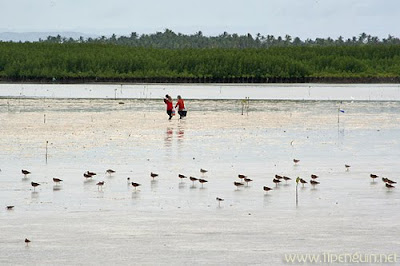The Olango Group of islands consists of seven islands. It lies between 10°16′N latitude and 124°03′E longitude. Located five kilometers east of Mactan Island, Olango Island and its satellite islets lies between the Bohol Strait to the south and the Camotes Sea to the north. To the east is the Olango Channel while to the west is the Gilutungan Channel.
Olango Island and its neighboring islets has a total land area of approximately 10.3 km² (1,030 hectares). The reef flat-lagoon surrounding the island of Olango is considered one of the most extensive reef areas in the Central Visayas. A total of 4,482 hectares of extensive sandy beach, rocky shoreline, inshore flats, seagrass beds, coral reefs, mangrove forest, mudflats, and salt marsh grass surround Olango and its satellite islets.
The Olango group of islands is an island group composed of the island of Olango and six satellite islets. The six neigboring islets are bounded by continuous fringing reefs (steep reef wall on the west and sloping reef at the east coast of Olango) and reef flats. The islands are low-lying with elevation reaching no more than 10 meters above sea level. At the center of these islands is a vast tidal flat, which includes the 920-hectare area of the Olango Island Wildlife Sanctuary.
Olango Island and its satellite islets are raised coral reefs. The lithology of the island consists of 2 unit types: the Plio-Pleistocene Carcar Formation and the Quaternary Alluvium (the youngest lithologic unit). Carcar formation is typically a porous coralline limestone characterized by small sinkholes, pitted grooves, and branching pinnacles. This suggests in situ deposition. Its dominant composition are shell, algae, and other carbonate materials, while macro and micro fossils are found abundant in its formation. Alluvium, on the other hand, is mostly found in the coastal areas. Calcareous sand derived from the weathering of limestone mostly makes up the tidal flat. This appears as fine to coarse-grained sand mixed with shell fragments.
Olango Island Wildlife Sanctuary
Olango Island is a diverse coastal ecosystem consisting of extensive coralline sandflats, mangroves, seagrass beds, and offshore coral reefs. The island's mangroves are most extensive in the Cebu province, and its offshore corals are home to scores of various marine species. The island is virtually flat, and it is surrounded by warm seas and partly sheltered from monsoons and strong trade winds.
Olango Island, situated off Mactan Island in Cebu, is one of the seven best-known flyways in the world for migrating birds. Its main attraction is its 920-hectare Olango Island Wildlife Sanctuary, a haven for migratory birds from Siberia, Northern China, and Japan. These birds flock to the island seeking refuge from the winter climate of other countries. The sanctuary supports the largest concentration of migratory birds found so far in the Philippines. There are 97 species of birds in Olango, 48 of which are migratory species, while the rest are resident birds of the island.
The birds use Olango as a major refueling station as well as a wintering ground. The birds stop by the island on their southward journey to Australia and New Zealand and on their journey back to their nesting grounds. Among the frequent guests are Chinese egrets, Asiatic dowitchers, Eastern curlews, plovers, sanpipers, Black-tailed Godwit and Red Knot. It is best to visit Olango around the months of July to November just in time for winter in the Northern Hemisphere.
Dive sites
The island of Olango is also known for its dive sites. Tourists can dive in three different sites around the island.
Olango Island has one of the deepest wall dives around. Baring is along the North-Western side of the island and the wall starts at 60ft/20m and ends down to about 220ft/73m before disappearing on a gradual slope. Grey reef sharks, tuna, barracuda, snappers and jacks can be found around the area.
Slightly further south is Santa Rosa. The dive starts with a sandy bottom covered in soft corals, leading to a drop-off at 15m, descending to 50m. There is a good variety of reef fish in the shallows here, while further down you'll see fusiliers, catfish, jacks, snappers and sweetlips, among others.
SOURCE: http://en.wikipedia.org/wiki/Olango_Island_Group












